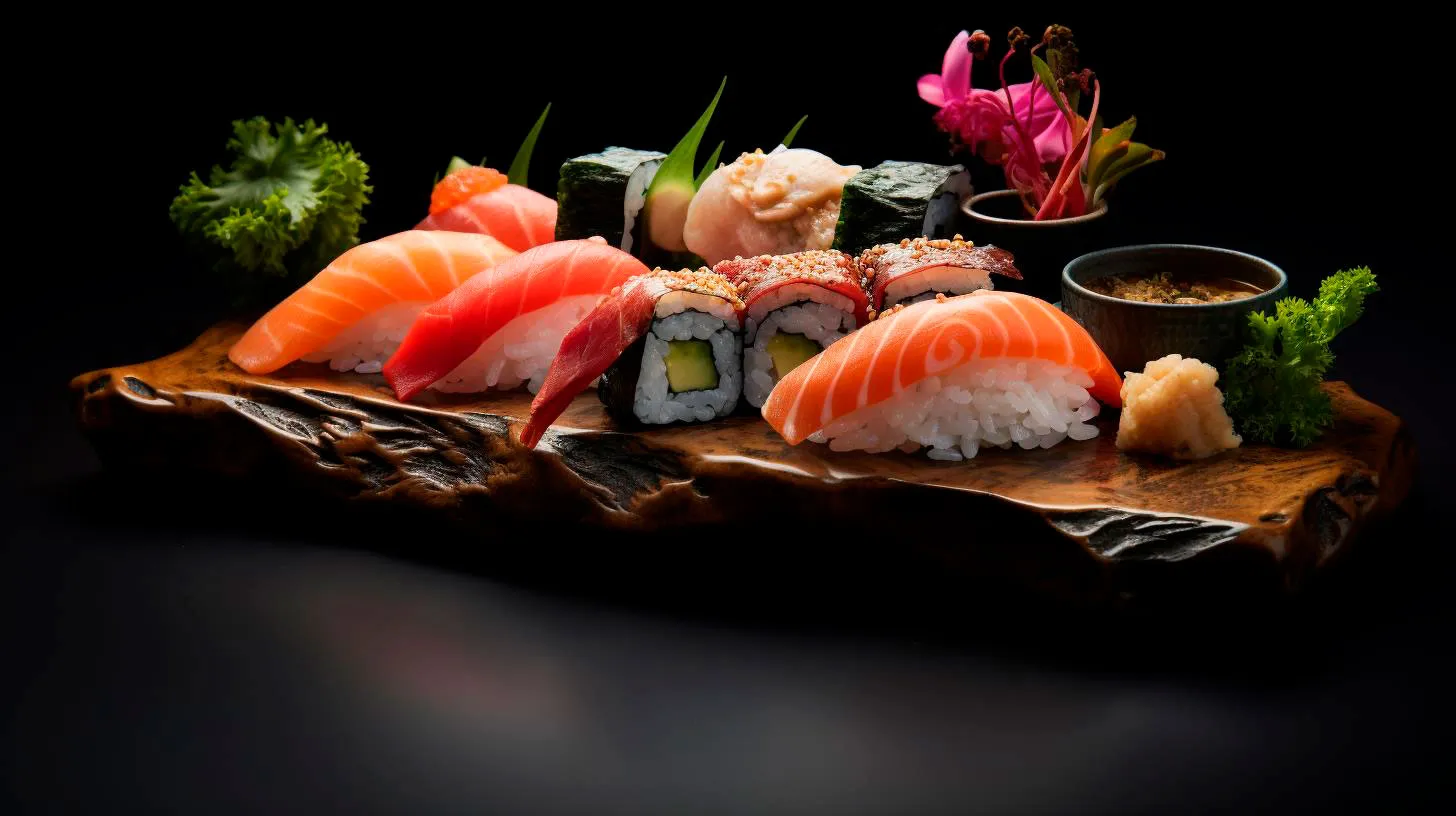The Art of Properly Washing and Rinsing Sushi Rice
However, a critical step often overlooked or not given enough attention is the proper washing and rinsing of sushi rice. In this article, we will explore the art of washing and rinsing sushi rice to achieve that sought-after sticky yet fluffy texture, along with important tips and techniques to enhance your sushi-making skills.
Why is Washing and Rinsing Sushi Rice Important?
Washing and rinsing sushi rice is a vital step that shouldn’t be skipped. By doing so, you remove excess starch from the rice, resulting in a cleaner and lighter final product. Properly washed rice also prevents it from becoming too sticky or clumpy, allowing it to absorb the perfect amount of seasoning during the cooking process. Moreover, rinsing rice helps remove any debris, dust, or impurities that may be present, ensuring a cleaner and safer meal for your enjoyment.
The Art of Washing Sushi Rice
Washing sushi rice might seem like a simple task, but it requires attention to detail and finesse. Follow these steps to master the art of washing sushi rice:
- Measure the Rice: Start by measuring the desired amount of sushi rice using a dry measuring cup. A general rule of thumb is using 1 cup of uncooked rice to make 3 to 4 sushi rolls.
- Rinsing: Place the measured rice in a fine-mesh sieve and rinse it under cool, running water. Gently swish the rice around with your fingers as the water passes through to remove any loose starch.
- Repeat: Continue rinsing and swishing the rice until the water runs clear. This step usually takes about 3 to 4 rinses, depending on the rice variety.
- Soaking: Once the rice is properly rinsed, transfer it to a bowl and add clean water. Let it soak for about 30 minutes to allow the rice grains to absorb water evenly, resulting in better texture when cooked.
- Draining: After soaking, carefully drain the water from the rice using a sieve or colander. Be gentle to avoid breaking or damaging the rice grains, which can affect the final texture.
By following these steps, you will have beautifully washed sushi rice, ready to be cooked and seasoned to perfection.
Bonus Tips for Perfectly Rinsed Sushi Rice
Here are some bonus tips to ensure your sushi rice is properly rinsed every time:
- Use a fine-mesh sieve: Using a fine-mesh sieve helps remove the starch efficiently without losing too much of the rice grains.
- Be gentle: Avoid vigorous scrubbing or rubbing the rice during rinsing, as it can damage the grains and affect the final texture of the rice.
- Adjust rinsing time: Depending on the type of rice you are using, the rinsing time may vary. Experiment to find the ideal number of rinses for the best results.
The Benefits of Properly Washing and Rinsing Sushi Rice
Properly washed and rinsed sushi rice offers a plethora of benefits:
- Enhanced Flavor: By removing excess starch, the flavors of the sushi rice become more pronounced and balanced.
- Improved Texture: Properly rinsed rice results in a sticky yet fluffy texture, making it easier to mold into various sushi shapes.
- Cleaner Presentation: Clean and washed rice yields visually appealing sushi rolls, enhancing the overall dining experience.
- Healthier Option: By removing debris and impurities, properly rinsed rice ensures a cleaner and safer meal for your health.
Remember, the art of properly washing and rinsing sushi rice is a fundamental aspect of making great sushi. Taking the time to master this technique will undoubtedly elevate your sushi-making skills and impress your friends and family.
So, the next time you prepare sushi at home, don’t overlook this crucial step. Embrace the art of washing and rinsing sushi rice, and unlock a world of delicious possibilities!
Essential Tips for Achieving the Ideal Sushi Rice Texture
The texture of the rice is the foundation of a good sushi roll and can make or break the overall taste. In this article, we will explore some essential tips to help you achieve that perfect sushi rice texture that will elevate your sushi-making skills to new heights.
1. Choosing the Right Rice
When it comes to sushi rice, quality is of utmost importance. Look for short-grain rice varieties such as Calrose or Japanese sushi rice, as they have the perfect stickiness required for sushi. Avoid long-grain rice varieties as they tend to be drier and lack the desired texture.
- Key Takeaway: Choose short-grain rice varieties like Calrose or Japanese sushi rice for the best results.
2. Proper Rice Washing Technique
Rinsing the rice thoroughly before cooking is essential for removing excess starch and impurities. Place the rice in a fine-mesh sieve and wash it under cold running water until the water runs clear. This step not only improves the texture but also prevents the rice from becoming overly sticky.
- Key Takeaway: Rinse the rice until the water runs clear to remove excess starch and prevent stickiness.
3. Accurate Rice-to-Water Ratio
The ratio of rice to water is crucial for achieving the ideal sushi rice texture. For every cup of rice, use around 1.25 cups of water. Adjust the amount slightly depending on the desired softness or firmness of the rice. Too much water can make the rice mushy, while too little can result in undercooked rice.
- Key Takeaway: Use a rice-to-water ratio of approximately 1.25:1 for perfect sushi rice.
4. Precise Rice Cooking
Once the rice and water are in the pot, bring them to a boil over medium-high heat. Then, reduce the heat to low and cover the pot, letting the rice simmer for about 15-20 minutes. Avoid lifting the lid during cooking to ensure even heat distribution. After the cooking time, allow the rice to steam off the heat for an additional 10 minutes before fluffing it with a rice paddle or fork.
- Key Takeaway: Simmer the rice on low heat, without lifting the lid, for 15-20 minutes, and let it steam off the heat for an additional 10 minutes.
5. Perfect Seasoning with Rice Vinegar
The seasoning of sushi rice with rice vinegar is what gives it its distinct and refreshing flavor. In a small saucepan, heat rice vinegar, sugar, and salt until dissolved. Once the rice is cooked and slightly cooled, gently fold in the seasoned vinegar mixture, taking care not to smash the grains, until the rice absorbs the flavors evenly.
- Key Takeaway: Season the sushi rice with rice vinegar, sugar, and salt to achieve that delicious tangy taste.
6. Proper Cooling and Moisture Control
Cooling the sushi rice properly is crucial to ensure the desired texture. Transfer the cooked rice to a large, shallow container and spread it out evenly. Use a hand fan or fanning technique while gently cutting and folding the rice. This helps the excess moisture evaporate and prevents the rice from becoming soggy.
- Key Takeaway: Cool sushi rice in a large, shallow container while fanning it to remove excess moisture and maintain the perfect texture.
Conclusion
Achieving the ideal sushi rice texture is a crucial step in creating a satisfying sushi experience. By following these essential tips, you can master the art of making perfectly textured sushi rice. Remember to choose the right rice, wash it thoroughly, maintain a proper rice-to-water ratio, cook it precisely, season it with rice vinegar, and cool it properly. With practice and dedication, you’ll soon be rolling out delectable sushi rolls that will leave your friends and family wanting more!
Choosing the Right Rice Variety for Perfect Sushi
The Importance of Rice in Sushi Making
Rice is not just a simple ingredient in sushi; it is the foundation upon which the entire flavor and texture of your sushi will be built. The right rice variety ensures that your sushi holds its shape, has the perfect balance of stickiness, and complements the flavors of the other ingredients.
When cooked, sushi rice should be tender, moist, and slightly sticky. It should easily hold its shape when molded into nigiri or rolled into maki. Achieving this consistency requires using the right rice variety with specific characteristics.
Key Rice Varieties for Sushi
Not every rice variety possesses the necessary attributes to create excellent sushi. Here are the key rice varieties that are commonly used in sushi preparation:
- Short-Grain Rice: Short-grain rice varieties are the most suitable for sushi. The grains are plump, round, and stick together when cooked, giving sushi its desired texture. Look for rice labels that specifically mention “sushi rice” or varieties like Calrose, Koshihikari, or Nishiki.
- Sticky Rice: Sticky rice, also known as glutinous rice, is another great option for sushi. Despite the name, it is gluten-free and gets its stickiness from amylopectin, a type of starch. Sticky rice is particularly popular in making sushi rolls due to its ability to hold fillings together effectively.
- Jasmine Rice: Although not traditionally used in sushi, jasmine rice can be an excellent alternative if short-grain rice varieties are not available. It has a fragrant aroma and a slightly sticky texture that can work well in sushi preparation.
Advantages of Using the Right Rice Variety
Choosing the right rice variety for sushi has several advantages:
- Texture: The right rice variety ensures that the sushi holds its shape and provides a pleasant mouthfeel when eaten. The grains should be tender but not mushy.
- Stickiness: Sushi rice needs to stick together without being overly sticky. This characteristic allows the rice to hold the fillings or maintain its shape when crafted into nigiri. The correct rice variety contributes to this ideal stickiness level.
- Flavor: The rice’s flavor should complement the other ingredients in your sushi. Depending on your preference, you can choose a rice variety with a mild, neutral taste or one that adds a slight sweetness to your sushi.
- Authenticity: If you aim to create authentic Japanese sushi, selecting the proper rice variety is essential. Traditional Japanese sushi is made using specific rice cultivars, ensuring an authentic taste and experience.
Key Takeaways
To sum up, when it comes to making perfect sushi, choosing the right rice variety is crucial. Here are the key takeaways to keep in mind:
- Select short-grain rice labeled as “sushi rice” or varieties like Calrose, Koshihikari, or Nishiki for optimal results.
- Consider using sticky rice if you prefer sushi rolls or need extra adhesive properties.
- Experiment with jasmine rice if short-grain options are not accessible.
- Ensure the rice has the desired texture, stickiness, and flavor to enhance your sushi experience.
- Achieve authenticity by using traditional rice varieties for a true Japanese sushi experience.
Remember, the right rice variety sets the foundation for amazing sushi. So, roll up your sleeves, select your preferred rice variety, and embark on a delicious sushi-making journey!
Mastering the Correct Ratio of Sushi Rice Vinegar
While the freshness of the fish and the art of rolling play essential roles, it is the perfect balance of sushi rice and vinegar that truly elevates this dish to perfection.
Understanding the Importance of Sushi Rice Vinegar
The sushi rice vinegar, also known as “sushi-su” in Japanese, is the key ingredient responsible for adding flavor and giving sushi rice its distinct taste. Apart from imparting a tangy-sweet flavor, the vinegar also serves as a preserving agent, ensuring the sushi’s longevity while enhancing its visual appeal.
To master the correct ratio of sushi rice vinegar, we must first appreciate the balance between acidity and sweetness. Japanese sushi masters have long understood that the ideal ratio not only enhances the rice’s flavor but also complements the variety of fish, vegetables, and condiments carefully nestled within the sushi roll.
The Perfect Ratio Unveiled
After thorough research and experimentation, we have found that the optimal sushi rice vinegar ratio is 1 part vinegar to every 5 parts of cooked sushi rice. This ratio strikes the right balance between acidity and sweetness, ensuring that the vinegar neither overwhelms the rice nor becomes inconspicuous within the roll.
By adhering to this ratio, you can expect the following benefits:
- Enhanced flavor: The balanced ratio of sushi rice vinegar amplifies the taste of the rice, creating a harmonious fusion of flavors with the fish or other ingredients.
- Improved texture: The vinegar helps to slightly break down the starch in the rice, resulting in a slightly sticky texture that holds the sushi roll together perfectly.
- Extended shelf life: The acidity in the sushi rice vinegar acts as a natural preservative, preventing the growth of harmful bacteria and extending the shelf life of the sushi.
These advantages will surely delight your taste buds and elevate your sushi-making skills to new heights!
Expert Tips for Mastering the Correct Ratio
Now that you know the ideal ratio, here are a few expert tips to ensure your sushi rice vinegar is blended perfectly:
- Choose the right vinegar: Opt for high-quality rice vinegar when preparing sushi. The delicate taste and mild acidity of rice vinegar perfectly complement the sushi rice.
- Season the rice gradually: Gradually mix the vinegar into the rice, allowing it to absorb the flavor without becoming excessively tart. This technique ensures an even distribution of flavor.
- Fan the rice for optimal texture: To achieve the desired texture, gently fan the rice while incorporating the vinegar. This helps remove excess moisture and introduces a subtle glossiness.
Conclusion
Mastery of the correct ratio of sushi rice vinegar is an essential skill for any sushi aficionado. By balancing the tangy-sweet notes, it enhances the sushi rice’s flavor and texture, creating an unforgettable dining experience. Remember, the 1:5 ratio will take your sushi-making skills to another level, ensuring the perfect harmony between each roll’s ingredients.
So, don your apron, gather your sushi-making tools, and embark on an epicurean adventure as you master the art of sushi rice vinegar!



